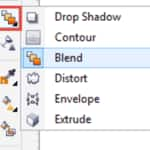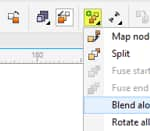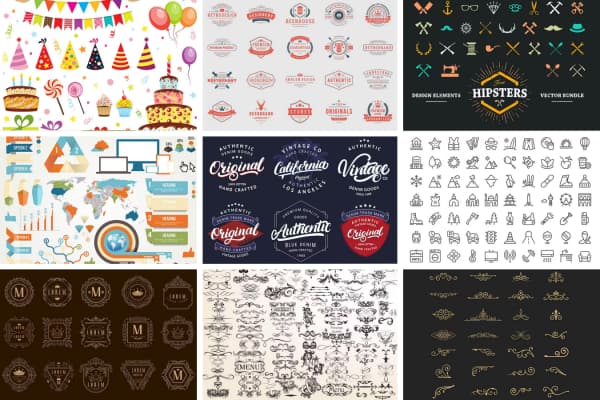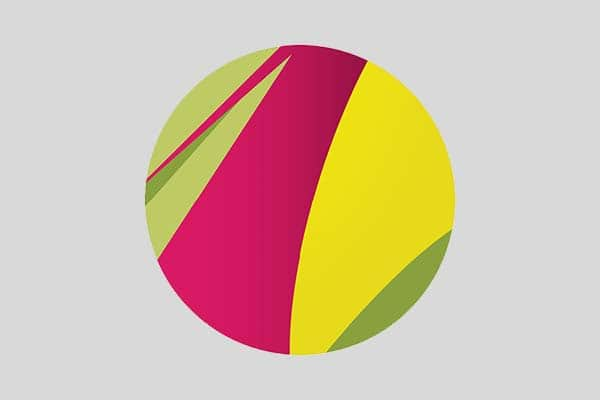By Anna María López López
This brief written tutorial shows you how to use some simple tools to create dynamic, three-dimensional objects in CorelDRAW.
This tutorial discusses:
- Using the Blend tool’s improved capacity in recent versions of CorelDRAW
- What are Blends and how are they created in CorelDRAW
- How to create three-dimensional objects using the “Blend along full path” command
Start your FREE 15-day trial and embark on a design journey with powerful tools for vector illustration, layout, photo editing, typography, and collaboration.
What’s New in CorelDRAW Graphics Suite
The Blend tool is a long-known CorelDRAW tool but its functionality has been improved over the past few years, specifically in the more interactive way in which blends are applied to objects.

A blend is like a metamorphosis or morphing between two objects.
You will need two objects in order to create a blend. One will be the starting point and the second will become the end point of the blend. The blend is in fact a progression of overlapping objects along a path. The shape, as well as the fill and outline of the objects, are progressively modified to take on the shape of the selected starting and ending objects.
The Blend tool is one of the most versatile tools in CorelDRAW, that’s why it’s very useful to understand its power. To help you discover it, let’s create a simple 3D-effect using the Blend tool.
To start, you must create all the elements that will be “blended”. Using the Ellipse tool draw two circles and apply a radial fountain fill to them.
Then, using the Freehand tool draw a path that will function as the blend trajectory.

Once all the elements have been created, select the Blend tool and left-click on the left circle. Then, without releasing the mouse button drag the cursor and position it over the second circle. Release the mouse button and the blend is practically done.

Select the blended group and click on the New path icon in the property bar. The cursor will change into a wavy black arrow.

Click on the path that you had previously drawn and the blend will take on the shape of this path.

If you want to obtain a more elaborate appearance, select the new blended group and click on the More blend options in the property bar. Enable the Blend along full path check box.

The objects will now get automatically distributed along the full path.

You can enhance this effect by increasing the number of steps in the blend or changing the size of the first or second object. The Blend tool is highly interactive and will allow you to see the changes as you make them.

Changes to the number of steps in the blend or to the first or second object will render different results. Remember that you can also move the nodes of the initial path and the blend will follow these changes interactively as well.

Once you’re satisfied with the resulting blend and you no longer need to interactively alter its properties, you can delete the path. To do this, go to the Object menu > Break Blend Apart. Then, click the path and remove it using the Delete key.

As you can see, the Blend tool can be used to create three-dimensional effects. But why stop there. This same technique of fitting a blend to a path allows you to create a variety of shapes. Simply change the number of steps and the shape of the path or objects that will serve as path, and you will discover that you can create very interesting effects such as the one shown below.

—————
This tutorial has been produced by Anna María López López – multidisciplinary designer, founder of www.corelclub.org and author of numerous digital design books such as www.cursodisenografico.net.
Source: http://www.corelclub.org/tutorial-creando-formas-con-volumen-y-aspecto-3d/
 CorelDRAW Graphics Suite
CorelDRAW Graphics Suite
 Ultimate Vector Bundle Vol. 1
Ultimate Vector Bundle Vol. 1
 CorelDRAW Standard 2021
CorelDRAW Standard 2021
 Ultimate Vector Bundle Vol. 2
Ultimate Vector Bundle Vol. 2
 Corel Vector
Corel Vector
Start your FREE 15-day trial and embark on a design journey with powerful tools for vector illustration, layout, photo editing, typography, and collaboration.

